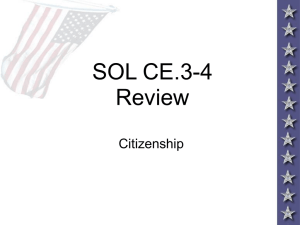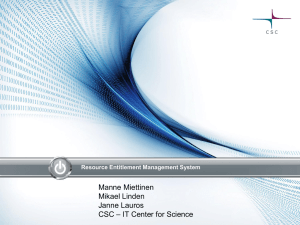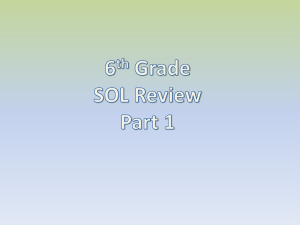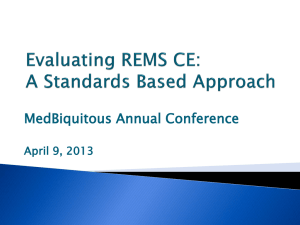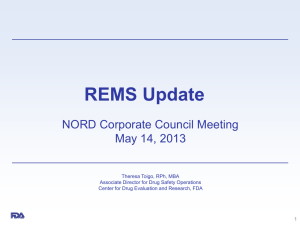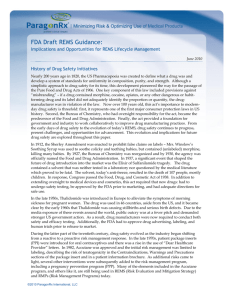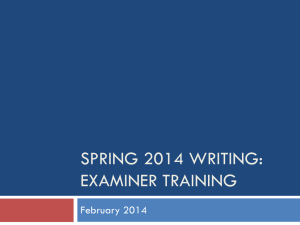PPT version - Ashima Research
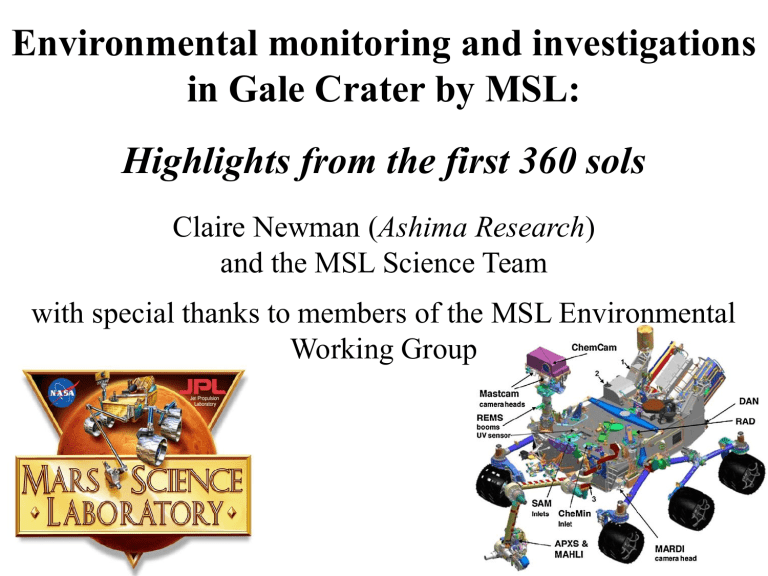
Environmental monitoring and investigations in Gale Crater by MSL:
Highlights from the first 360 sols
Claire Newman ( Ashima Research ) and the MSL Science Team with special thanks to members of the MSL Environmental
Working Group
Overview of MSL’s environmental instrument suite
Dedicated environmental sensors on MSL
The Rover Environmental
Monitoring Station
(REMS)
(A) Ground temperature sensor
on boom 1 (not shown)
(B) Wind sensor on boom 1
(not shown, and was damaged on landing) and boom 2 (shown)
(C) Relative humidity sensor on boom 2
(D) Air temperature sensor on boom 1
(not shown) and boom 2 (shown)
(E) UV sensor on the rover deck
(F) Pressure sensor inside the rover body
In this selfportrait, boom 1 is hidden behind the rover mast
Dedicated environmental sensors on MSL
The Radiation
Assessment Detector
(RAD)
[see later talk by Zeitlin et al.]
Measures a broad spectrum of energetic particle radiation
Dedicated environmental sensors on MSL
The Dynamic Albedo of
Neutrons instrument(DAN)
[see later talks by Litvak et al. and Moersch et al.]
Detector and electronics
Pulsed neutron generator (used in active mode)
Measures thermal and epithermal neutrons to infer sub-surface water abundance and (in active mode) vertical distribution in 1 st ~m below surface
Many investigations also being performed by:
• MSL’s cameras (Mastcam, Navcam, MAHLI, …)
[see e.g. previous talk by Bell et al.]
• ChemCam spectroscopy
[see e.g. Wednesday talk by Mcconnochie et al.]
• Sample Analysis at
Mars (SAM) instrument
[see e.g. later talks by Mahaffy et al. and Webster et al.]
Why do we care about the environment in Gale Crater?
Motivation for environmental monitoring
• Gives context for wide range of studies & experiments
• Provides data for future mission planning
• Massively expands record of in situ Mars meteorology
• Measuring the current environment helps identify
ancient vs. new features and processes
• Understanding the current environment is vital for extrapolating to the past
• Provides insight into past climate states
Selected highlights from MSL’s environmental investigations
100
Water in the atmosphere [REMS RH]
Diurnal cycles of temperature and relative humidity over three sols sol 15 sol 16 sol 17
0
-20
50
-40
0 -60
-50
00:00
Measured RH
Temperature (K)
12:00 00:00 12:00
RH simulated for vmr = 140 ppm
RH simulated for vmr = 100 ppm
RH simulated for vmr = 60 ppm
00:00 12:00
Local time of day
NOTE: Data are preliminary. See Harri et al., JGR (2013) for more details of the RH sensor
-80
-100
00:00
60
40
Water in the atmosphere [REMS RH]
140
Seasonal evolution of early morning temperature and water volume mixing ratio consistent with orbital data
120
Southern
Winter
100
80
Southern spring Southern summer
-60
-70
-80
20
0 50 100 150 200
Leave blast zone
Arrive in
Rocknest
Leave
Rocknest
Arrive at
Yelloknife
Mission sol
250 300 350
Start rapid transit route
NOTE: Data are preliminary. See Harri et al., JGR (2013) for more details of the RH sensor
Water in the surface [DAN]
Most DAN active data fit a 2-layer model with a relatively water-poor top layer; wt% consistent with SAM soil analysis
DAN modeled weight % water along rover track water in bottom layer water in top layer (~top 10-20cm)
See later talks by Litvak and Moersch, and papers by Jun, Litvak, and Mitrofanov, et al., JGR (2013)
Aeolian features and processes [cameras]
Dunes near Mount Sharp
(from orbit)
Ventifacts in Hottah
Plausible wind directions based on dune morphology
Jake
Matijevic rock
Rocknest
‘sand shadow’ Obstacles sand
Inferred directions wind comes from based on ventifact orientations
[From Bridges et al., JGR (2013)]
Aeolian features and processes [REMS wind]
REMS wind directions at 4 times of day in 3 periods
09:00-10:00 13:00-14:00 N
18:00-19:00
Sol 38-55
Sol 55-120
Sol 121-160
21:00-22:00
REMS team
• REMS (and model) wind directions more consistent with winds implied by dunes than by rock abrasion features [see tomorrow’s Bridges et al. poster]
• May indicate dunes more recent, while rocks hold record of ancient winds
Aeolian features and processes [REMS, Mastcam]
Experiments to estimate threshold for particle motion:
Constant REMS wind monitoring between 2 Mastcam images
If change detected => REMS peak winds give upper limit on threshold
If NO change seen => REMS peak winds give lower limit on threshold
Image1: sol 232, 12:03 LMST Image2: sol 232, 12:46 LMST
3 sets of experiments,
each using a pair of images of a postdrilling dump pile
Found NO change between images, and peak REMS winds ~16m/s
Suggests surface stress must exceed ~0.02-0.04 Pa for particles to move
Topography and the circulation [REMS wind]
As shown before, flow is not simply ‘daytime upslope / nighttime downslope’ with respect to Mount Sharp
09:00-10:00 13:00-14:00 N
18:00-19:00
Sol 38-55
Sol 55-120
Sol 121-160
21:00-22:00
Upslope at night
Downslope during the day
N
REMS team
Topography and the circulation [REMS pressure]
Enhanced daily range in REMS surface pressure compared to
ALL prior landing sites measured
Mars Pathfinder
2 sols of pressure data
MSL
3 sols of pressure data
680 sol 9
670
660
Peak amplitude
~ 4.5% sol 19 Peak amplitude
~ 13%
650
Schofield et al., 1997 Haberle et al. 2013b
Main cause is hydrostatic adjustment along major slopes in Gale in response to daily air temperature cycle [Richardson et al., JGR 2013]
Surface properties [REMS T
ground
]
Modeling REMS’s daily ground temperature cycle
0 4 8 12 16 20 24
Hour (LMST)
0 4 8 12 16 20 24 0 4 8 12 16 20 24
Hour (LMST) Hour (LMST)
• Vary model parameters – e.g. thermal inertia, albedo, atmospheric opacity – until find best fit to observations
• Overall, best fit parameters are consistent with sand-sized soil particles
• Remaining mismatches suggest a more complex response to incident solar insolation, due to e.g. sub-surface layering
See e.g. Renno/Martinez et al. poster on Tuesday, Hamilton et al. poster on Thursday,
Vasavada talk on Friday, and upcoming Hamilton et al. JGR paper
Surface properties [REMS T
ground
]
Observed daily δT ground and contours of predicted δT ground as a function of season and thermal inertia (assuming constant albedo and opacity)
100
95
90
85
80
75
70
65
60
0 50 100 150 200 250
Mission sol
300 350
See Hamilton et al. poster on Thursday
Atmospheric dust and impact [Mastcam]
MSL and Opportunity visible opacities up to ~sol 350
MSL Mastcam opacities are very similar to those at
Opportunity, except during e.g.
the Ls~208° regional storm
Courtesy of Mark Lemmon
Atmospheric dust and impact [REMS pressure]
880
870
860
850
840
830
820
810 sol 96
800
790 sol 97
780
770
0 4 8 12 16 20
Hour, LMST
Big change in shape of daily pressure cycle from sol 96 to sol 97 as a regional dust storm develops near Gale
24
* REMS semi-diurnal pressure tide amplitude
Opportunity optical depth
THEMIS 9μm optical depth x5
MSL optical depth +
In fact, storm onset was first detected via the increased amplitude of the semi-diurnal pressure
tide (shown in black)
From Haberle et al. 2013b
Atmospheric dust and impact [REMS, Navcam]
Dust devils (dust-filled convective vortices) are thought to be important for ‘background’ dust lifting on Mars
Signature of vortex passage in REMS pressure data Vortex incidence around noon (11am-1pm LMST)
Courtesy of
Henrik
Kahanpää
From Harri et al., 2013a
• REMS has measured dozens of vortices in pressure data
• A few may also be associated with small fluctuations in UV
• However, NO definitive dust devils have yet been imaged
And many more studies and findings…
• SAM atmosphere and rock isotope studies provide insight into past environment in Gale [see earlier Mahaffy et al. talk]
• RAD monitoring shows impact of solar cycle and air mass on surface radiation environment [see later Zeitlin et al. talk]
• MSL environmental data are helping calibrate present day
Mars models & improving their ability to simulate the past
• Stay tuned for lots more from MSL’s environmental instruments and investigations!
Firsts for MSL’s environmental investigations
• First comprehensive environmental monitoring instrument
suite to be landed on the Martian surface
• First UV and energetic particle radiation measurements from the surface of Mars
• First measurements of sub-surface water abundance and
distribution from the surface of Mars
• First attempt to measure threshold for particle motion on Mars
• Gale Crater is first landing site to provide ability to study the effects of major topography on the environment
• First comprehensive 1Hz meteorological dataset for Mars
• Also first surface meteorology since Phoenix, and first long-term environmental monitoring since Viking
